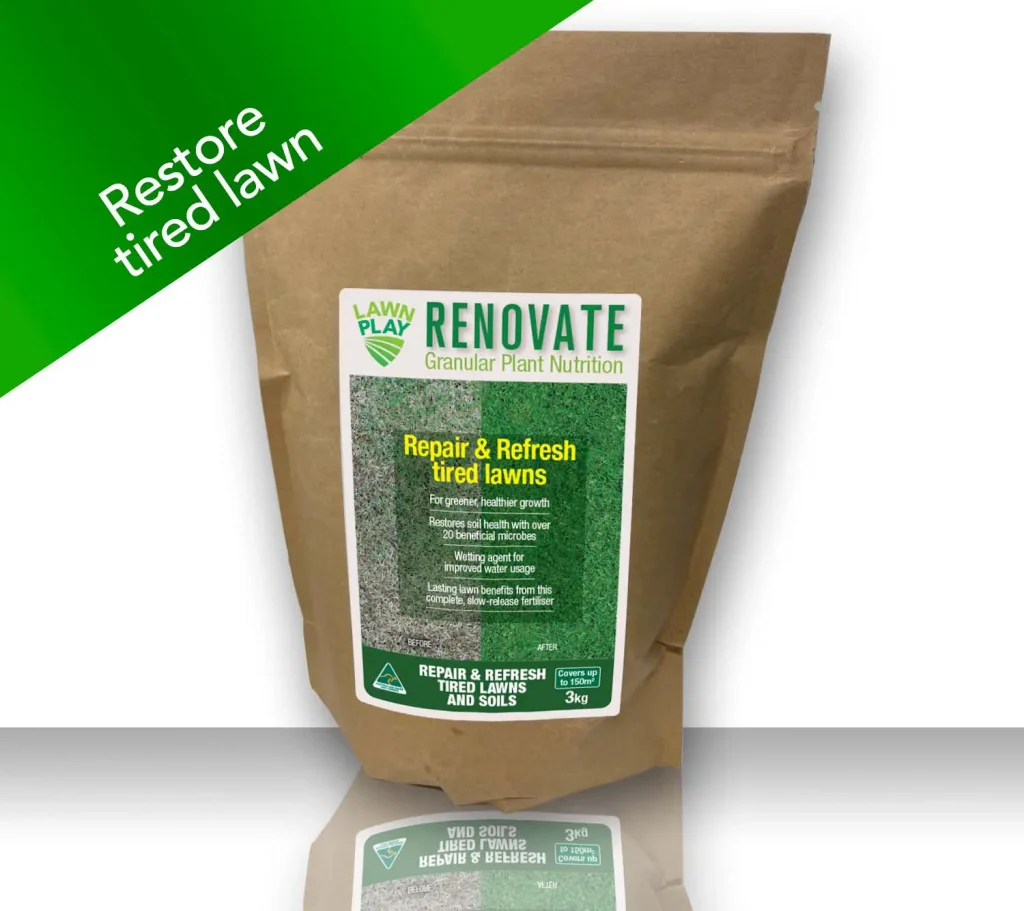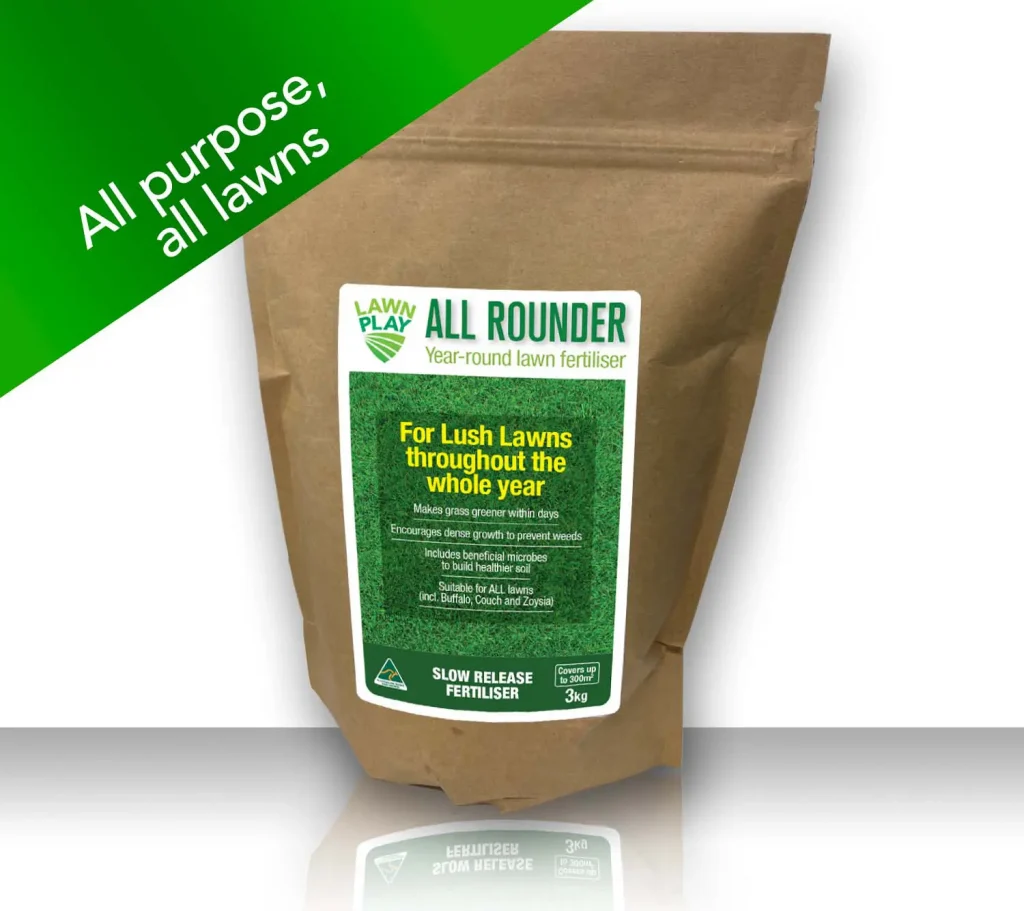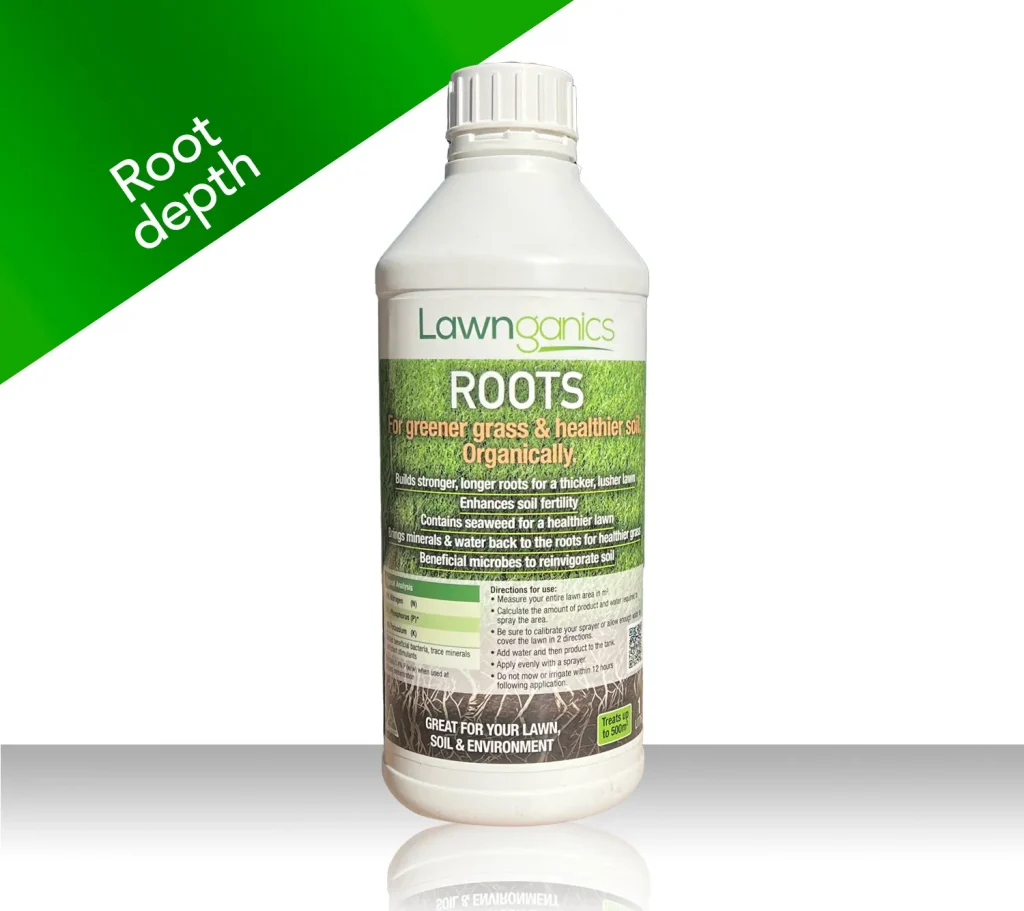
Zoysia lawns are a popular choice for many Australian homeowners due to their unique characteristics and resilience. Zoysia grass is a warm-season grass that thrives in hot, humid conditions, making it an ideal choice for the Australian climate.
One of the key characteristics of Zoysia lawns is their dense, low-growing nature. This makes them ideal for areas where foot traffic is heavy, as they can withstand wear and tear better than many other grass types. Zoysia lawns also require less mowing than other grass types, which makes them a low-maintenance option for busy homeowners.

In Australia, there are several popular varieties of Zoysia grass, including Zoysia japonica, Zoysia matrella, and Zoysia tenuifolia. Each variety has its own unique characteristics, such as tolerance to shade or drought, making it important for homeowners to choose the right variety for their specific needs.
One of the reasons why Zoysia lawns have become so popular in Australia is due to the breeding efforts that have been made to improve their characteristics. For example, some Zoysia varieties have been bred to be more resistant to disease and pests. This is while others have been bred to require less water or fertiliser. These improvements make Zoysia lawns a more sustainable and eco-friendly option for homeowners who want a lush, green lawn without harming the environment.

Three positives for Zoysia lawns
There are several advantages of choosing Zoysia lawns over other warm-season grasses available in Australia. Here are three of the big positives:
- Low maintenance: Zoysia lawns require less maintenance than many other warm-season grasses. They grow more slowly, so they require less mowing. Moreover, they have natural resistance to many pests and diseases, reducing the need for chemical treatments.
- Drought tolerance: Zoysia grass has excellent drought tolerance. This means it can survive in hot and dry conditions with minimal watering. It’s an ideal choice for homeowners who want a lush lawn without having to use excessive amounts of water.
- Wear resistance: Zoysia grass is highly wear-resistant and can withstand heavy foot traffic without becoming damaged or discoloured. This makes it a popular choice for areas with children, pets or high levels of foot traffic, such as sports fields or public parks.
Three negatives for Zoysia lawns

While Zoysia lawns have many advantages, there are also some potential downsides to consider. Here are three of the negatives:
- Slow establishment: Zoysia lawns can take longer to establish than some other warm-season grasses. This means, it can take longer for your lawn to reach its full potential. This can be frustrating for homeowners who want a lush lawn as quickly as possible.
- Higher cost: Zoysia grass is typically more expensive than other warm-season grasses. It’s both in terms of the initial cost of purchasing and installing the grass and ongoing maintenance costs. This can be a significant factor for homeowners on a budget.
- Not suitable for all climates: While Zoysia lawns are well-suited to the hot, humid conditions of many parts of Australia, they may not be the best choice for areas with cooler climates or harsher winter conditions. In these areas, other warm-season grasses may be a better choice.
How often should you mow a zoysia lawn?

The frequency of mowing a zoysia lawn depends on the specific variety of zoysia. Consider as well other factors such as temperature, moisture levels, and nutrient availability. In general, zoysia grass grows more slowly than other warm-season grasses, so it requires less frequent mowing.
The goal for a healthy mowing program is to never remove more than one-third of the grass blade at a time when mowing your zoysia lawn. This helps to promote healthy growth and prevents the grass from becoming stressed or damaged. Should this happen, this product helps the plant become more resilient to stress.
This means that during the growing season, in most Australian areas, you should aim to mow your zoysia lawn about once per week. However, you may need to cut more frequently if you are a lower cut Zoysia lawn,
During the cooler months when zoysia grass growth slows down, you may only need to mow once every 2-4 weeks. It depends on the climate you have where you live.

What height should you cut a zoysia lawn?
The ideal height for cutting a zoysia lawn depends on the specific variety of zoysia. Consider also the growing conditions and climate and the type of mower you are using. However, in general, zoysia lawns should be cut to a height of around 20-40mm if cut with a rotary mower and 10-25mm if cut with a cylinder mower.
It’s important to avoid cutting zoysia grass too short, as this can damage the grass and leave it vulnerable to pests, diseases, and drought. On the other hand, allowing the grass to grow too long can make it more difficult to maintain and can result in a less attractive lawn.
How low can Zoysia lawns be maintained? Can you make a putting green or bowling green out of Zoysia?

Zoysia lawns can be maintained below 5mm. So, if you have Zoysia at your property and want to challenge yourself to create a putting green then you are in luck. Zoysia grasses are used on golf courses fairways around the world. In rare circumstances, they’re also used as a putting greens (usually Couch or Bent grass are preferred playing surfaces).
There is a lot of work involved in maintain zoysia sub 5mm, but it is possible. Some more modern varieties of Zoysia have been breed to be dwarf varieties. This variety may be more suitable if available in your area.
How much water do zoysia lawns need each week?
The amount of water that a zoysia lawn needs each week depends on various factors, such as temperature, humidity, soil type, and rainfall. As a general rule, zoysia grass requires about 20-30mm of water per week during the peak growing season.
However, it’s important to avoid overwatering your zoysia lawn. This can lead to shallow root growth, fungal diseases, and other issues. Instead, water your lawn deeply and infrequently, allowing the water to penetrate the soil to a depth of 10-15 centimetres.
To determine how much water your zoysia lawn is receiving, you can use a rain gauge or some catch cups placed on your lawn.
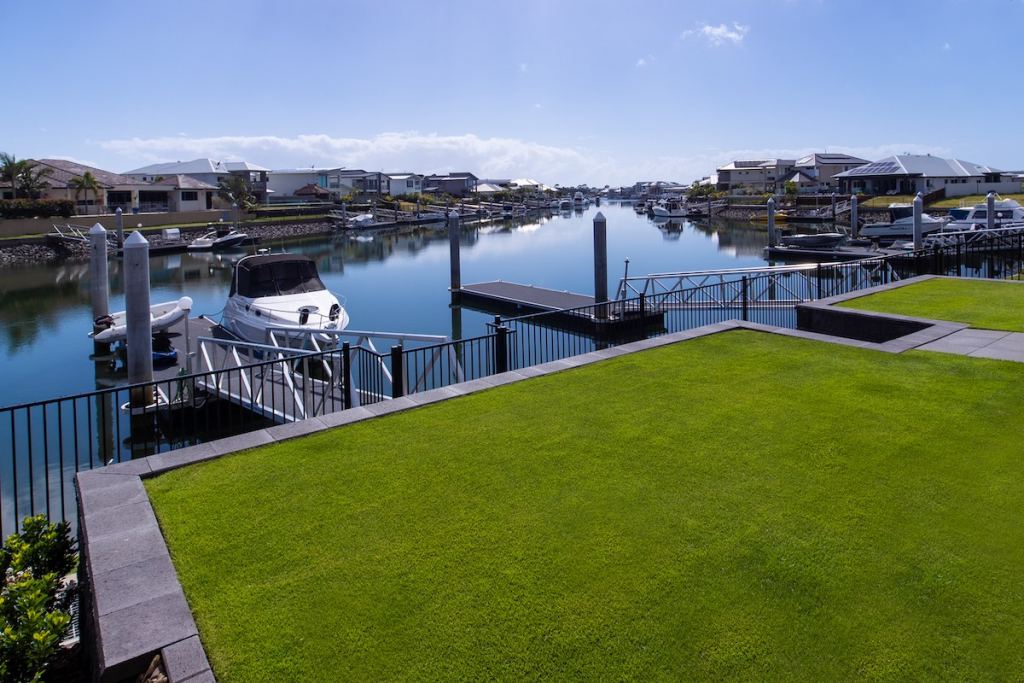
What is the best fertiliser for Zoysia Lawns?

The best specific fertiliser for your Zoysia lawn will depend on the time of year. This includes the goal you have for your lawns and the starting state of your lawn. So there is no such thing as a one size fits all fertiliser. So, with that said here are the products that we use, and what situations we use them in.
Best fertiliser for rapid Zoysia recovery: Lawn Play Renovate
Zoysia is a fairly slow growing. This means it can need quite a bit of help to recover, Renovate has high rate of carbon coated nitrogen. This results in much faster growth.
It also has a full spectrum of trace elements with helps with the overall health of the plant.
If you have a patchy lawn, or your lawn has lost vigor and colour then this is a great option.
Click here to read more.
Increase Zoysia Colour Without Increasing Growth: Lawnganics Brilliance
A common mistake I see is when a lawn is fairly healthy, is for people to put down a high nitrogen fertiliser at a high rate when they start to notice a drop in colour (as this is often what they used to get the lawn looking great in the past).
The problem is that the nitrogen then causes too much excessive growth. This leads to a thatchy lawn that is easy to scalp.
Brilliance is a liquid fertiliser that has a very low rate of nitrogen and a high rate of iron. This will cause a rapid greening of the lawn but only minimal extra growth.
Click here to read more.
Slow Release Fertiliser For Healthy Zoysia Lawns: Lawn Play All Rounder
Slow release fertilisers are the best fertilisers for most Aussie households. Whilst they are not as good at repairing a tired lawn, they are fantastic at maintaining healthy lawns (especially for busy lawn lovers).
All Rounder has two forms of slow release nitrogen so it can last around 2-3 months per application. It also includes a full spectrum of trace elements which is great for lawns overall health.
Click here to read more.
Encourage Root Growth in Zoysia Lawns: Lawnganics Roots
Encouraging deep root is very important to Zoysia growth, especially in hot areas.
Roots is a combination of organic fertilisers and soil health stimulants like mycorrhizal fungi, humates and kelp that help promote root growth.
Click here to read more.
There are a whole host of fertilisers that a suitable to use on Zoysia grass here. We use and recommend products from The Lawn Shed all the time.
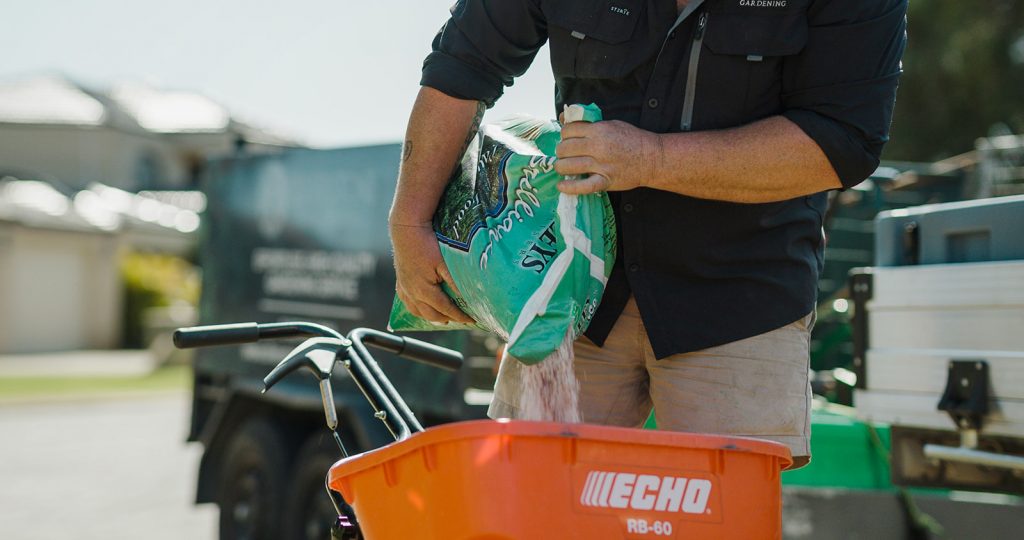
How often should Zoysia lawns be fertilised?
The best frequency for fertilising you Zoysia lawn will depend on the time of year, the type of fertiliser you are using and your goals for the lawn.
As a general rule, when using granule fertilisers Zoysia lawns should be fertilised about every 8-10 weeks during the growing season. When using liquid fertiliser Zoysia lawns should be fertilised every 2-4 weeks.
During periods of high growth, such as in the spring and summer, the lawn may require more frequent fertilization to maintain its health and appearance. Conversely, during cooler periods or when the lawn is not actively growing, fertilisation may not be necessary or may require less frequent application.
To apply the fertiliser, you can use a broadcast spreader or a handheld spreader. Be sure to follow the instructions on the fertiliser label. Apply the correct amount for your lawn’s size and needs. Avoid over-fertilising, as this can lead to excessive growth and other issues. It’s also a good idea to water your zoysia lawn thoroughly after fertilising. This will help to distribute the nutrients evenly and prevent them from leaching away
Can zoysia lawns be vertimowed?

Yes, zoysia lawns can be vertimowed. Vertimowing, also known as scarifying or dethatching, involves using a specialised machine, with vertical blades, to removeis the layer of dead grass, roots, and other debris that accumulates on the soil surface known as thatch.
While zoysia grass is relatively low-maintenance and typically doesn’t require frequent vertimowing, it can benefit from the process if the thatch layer becomes too thick. This can occur if the lawn is not properly maintained, if excessive fertilising or watering.
It’s generally best to vertimow zoysia lawns during the growing season. You may observe this when the grass is actively growing and can recover more quickly from the process.
Should you aerate your Zoysia lawn?

Yes, aerating your Zoysia lawn can be beneficial for its health and overall appearance. Aeration involves creating small holes in the soil to allow air, water, and nutrients to penetrate deeper into the roots. This can help to relieve soil compaction, improve drainage, and stimulate root growth.
In particular, Zoysia lawns that are subject to heavy foot traffic will benefit from aeration. The best time to aerate a Zoysia lawn is during the growing season, typically in late spring or early summer. If your lawn gets waterlogged in winter then aeration may also help with some drainage issues you have.
When aerating your Zoysia lawn, it’s important to use the right equipment. A core aerator, which removes small plugs of soil from the lawn, is often recommended for Zoysia lawns. Be sure to aerate when the soil is slightly moist as that helps the aerators tines to get deeper into the soil profile, providing more benefit for your lawn..
After aerating your Zoysia lawn, it’s important to water it well to help the soil settle and the grass recover. You can also use this opportunity to apply fertiliser or topdressing. This involves spreading a thin layer of compost or other organic material over the lawn surface to provide additional nutrients and improve soil health. If you just need a small amount of compost, this is a great option; if you need a larger quantity the best option is to contact your local soil supplier.
What diseases are common with Zoysia lawns?
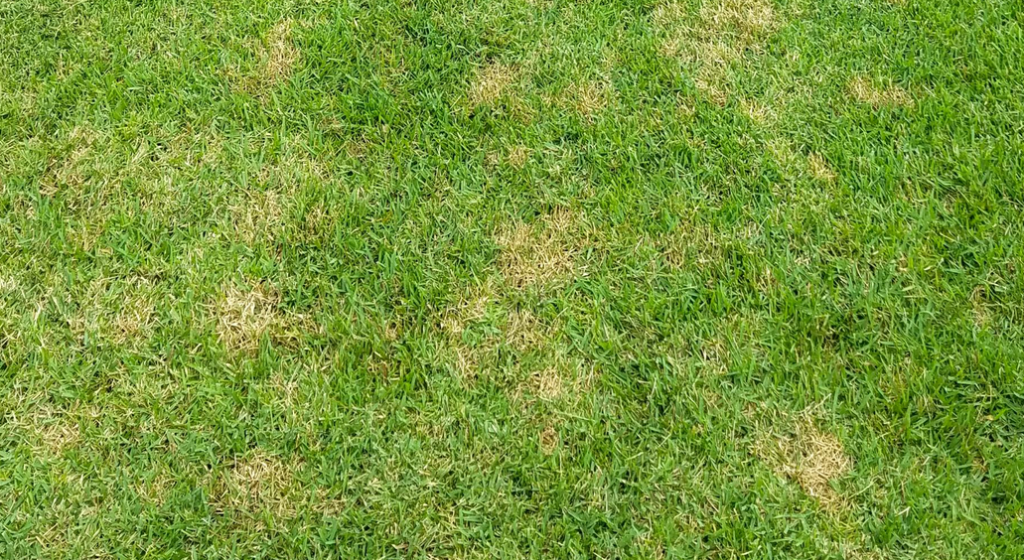
Zoysia lawns are generally considered to be relatively disease-resistant. However, they can still be susceptible to certain types of diseases, particularly if they are not properly maintained. Some of the most common diseases that can affect Zoysia lawns include:
- Brown Patch: This fungal disease appears as large, circular patches of brown, dead grass that may be surrounded by a yellow “halo”. Brown patch is most common in hot and humid weather conditions and can be controlled through proper lawn maintenance. Include if necessary, regular aeration and fertilisation, as well as fungicide applications.
- Dollar Spot: This fungal disease appears as small, circular spots on the lawn that are approximately the size of a silver dollar. The spots may merge together to form larger patches. Dollar spot is most common in humid weather conditions and can be controlled through regular fertilisation and fungicide applications.
- Rust: This fungal disease appears as orange-red, powdery spots on the grass blades and can be caused by a lack of nitrogen or excess moisture. Rust can be controlled by improving drainage and applying nitrogen-rich fertilisers.
Prevention is the best approach to controlling disease in Zoysia lawns. This includes maintaining proper irrigation and drainage, mowing at the correct height, and avoiding over-fertilising. If you suspect your Zoysia lawn may be affected by a disease, it’s recommended to consult with a professional landscaper or turf specialist for diagnosis and treatment options.
What pests are common with zoysia lawns?

Zoysia lawns are generally resistant to pests, but they can still be affected by some common lawn pests. Here are a few of the most common pests that can affect Zoysia lawns:
- Armyworms: Armyworms are the larvae of certain types of moths and can quickly strip a Zoysia lawn of its foliage. They are most active in late summer and early autumn and can be controlled with insecticides.
- Sod Webworms: These small caterpillars feed on Zoysia grass blades, causing them to turn brown and die. They are most active in the spring and early summer and can be controlled with insecticides.
- Mole Crickets: These burrowing insects can damage Zoysia lawns by uprooting the grass and causing it to die. They are most active in the spring and can be controlled with insecticides.
To prevent pest problems in Zoysia lawns, it’s important to maintain good lawn health through proper irrigation, fertilisation, and mowing practices. If you suspect your Zoysia lawn may be affected by pests, it’s recommended to consult with a professional landscaper or pest control specialist for diagnosis and treatment options.
How to control weeds in Zoysia Lawns

Controlling Broadleaf weeds in Zoysia lawns
Broadleaf weeds can be unsightly and can compete with your Zoysia lawn for nutrients and water. There are two main methods for controlling broadleaf weeds in Zoysia lawns: manual removal and selective herbicides like Bow and Arrow. Here are some pros and cons of each method:
Manual Removal:
Manual removal involves physically pulling the weeds out of the ground by hand. This method can be effective for small areas or isolated weeds, but may not be practical for larger infestations. Manual removal is chemical-free method of weed control and ha no risk of harming the lawn. However, it is very labour intensive and time consuming so is most likely not a realistic option for larger lawns.
Selective Herbicides:
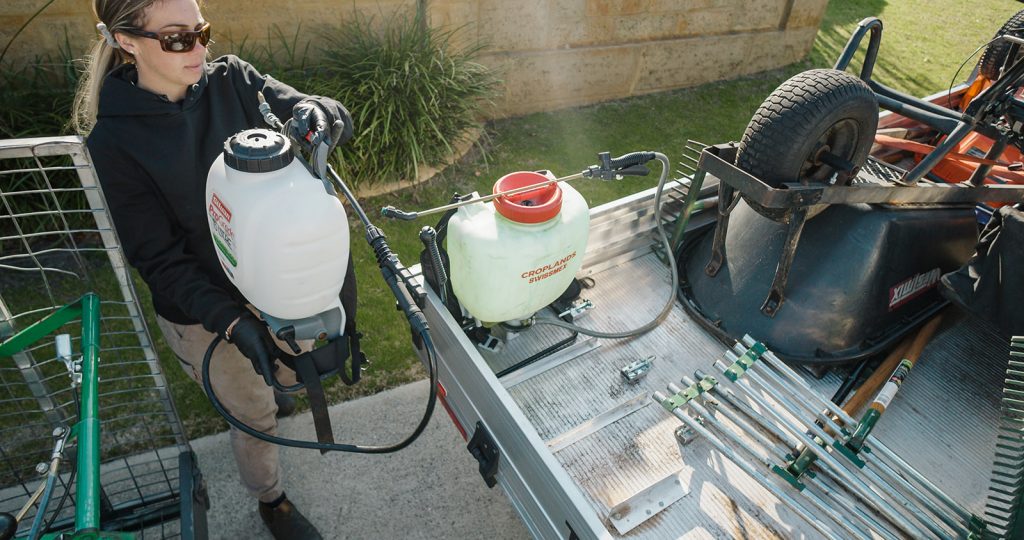
Selective herbicides like Bow and Arrow are designed to target broadleaf weeds while leaving the grass unharmed. These herbicides can be effective for larger infestations or widespread weed problems. These selective herbicides are much more effective for large infestations of broadleaf weeds and are easy to apply with a sprayer. However, if not used correctly these herbicides can do damage to the lawn, and some people prefer not to use harsh chemicals if they can avoid it.
When using selective herbicides, it’s important to follow the manufacturer’s instructions carefully to avoid harming the Zoysia grass or the surrounding environment.
In summary, both manual removal and selective herbicides like Bow and Arrow can be effective methods for controlling broadleaf weeds in Zoysia lawns. The best method will depend on the extent of the weed problem, the size of the affected area, and personal preferences for chemical-free or chemical-based weed control.
How to control wintergrass in Zoysia lawns
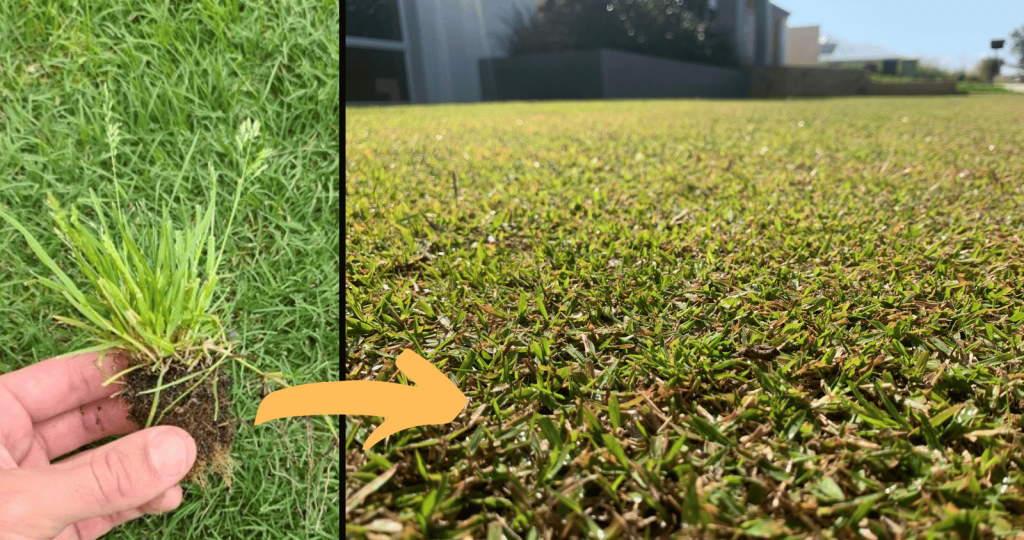
There are a few products on the market that can control wintergrass without damageing your Zoysia lawn. Products with Endothal are often the most common.
Endothal works by inhibiting the growth and development of the wintergrass, while leaving the Zoysia grass unharmed. It is most effective when applied to young wintergrass plants, before they have had a chance to establish a strong root system.
When using endothal to control wintergrass in Zoysia lawns, it’s important to follow the manufacturer’s instructions carefully. The herbicide should be applied in the cooler months, when the wintergrass is actively growing, and when the Zoysia grass is dormant or has slowed its growth.
One potential drawback of using endothal to control wintergrass is that it can take several weeks for the herbicide to take effect, and the dead wintergrass may remain visible in the lawn for some time. Additionally, endothal can be harmful to aquatic organisms, so care should be taken to avoid applying the herbicide near water sources.
How to prevent weeds in your lawns

The best way to control weeds in your lawn is to prevent them before they even emerge, this can be achieved with pre-emergent hebicides like Spartan or Barricade.
When using Barricade or Spartan as pre-emergent herbicides in Zoysia lawns, it’s important to follow the manufacturer’s instructions carefully. The herbicide should be applied evenly to the entire lawn using a sprayer or other applicator, and care should be taken to avoid overspray onto non-target plants or areas.
One of the benefits of using pre-emergent herbicides like Barricade or Spartan is that they can provide long-lasting weed control, often for up to several months. This means that fewer applications may be necessary throughout the growing season.
However, one potential drawback of using pre-emergent herbicides is that they can also prevent the growth of desirable plants, including newly-seeded grass or flowers. Therefore, it’s important to avoid applying these herbicides to areas where new growth is desired.
In summary, Barricade and Spartan can be effective tools for preventing weed growth in Zoysia lawns. However, they should be used with caution and following the manufacturer’s instructions carefully. Additionally, it’s important to note that the best way to prevent weed growth in a Zoysia lawn is through proper lawn care practices such as regular mowing, watering, and fertilization, as well as early detection and manual removal of any weeds that do appear.
